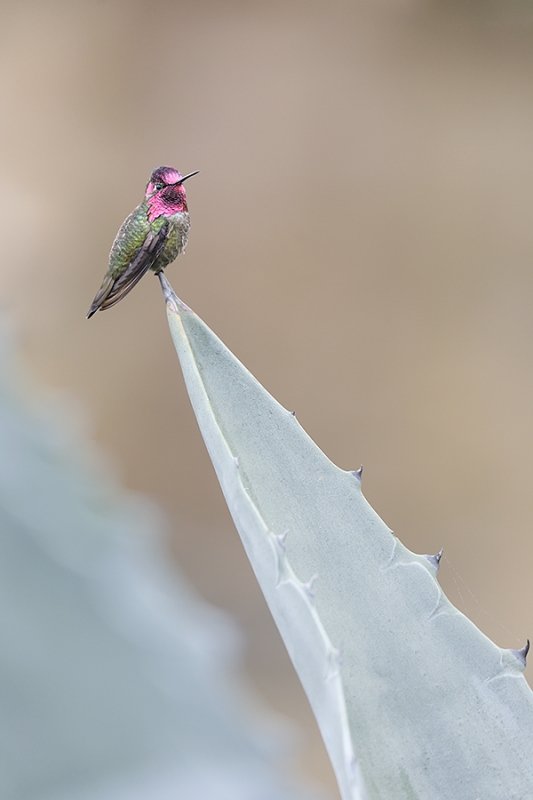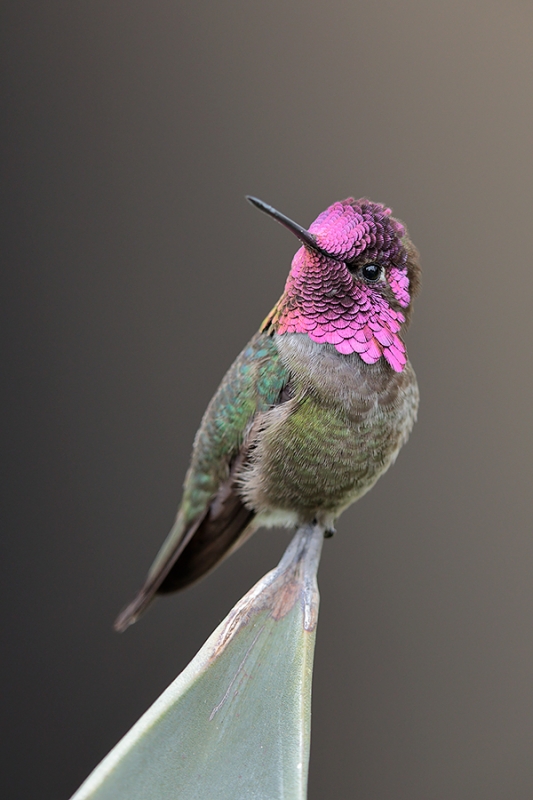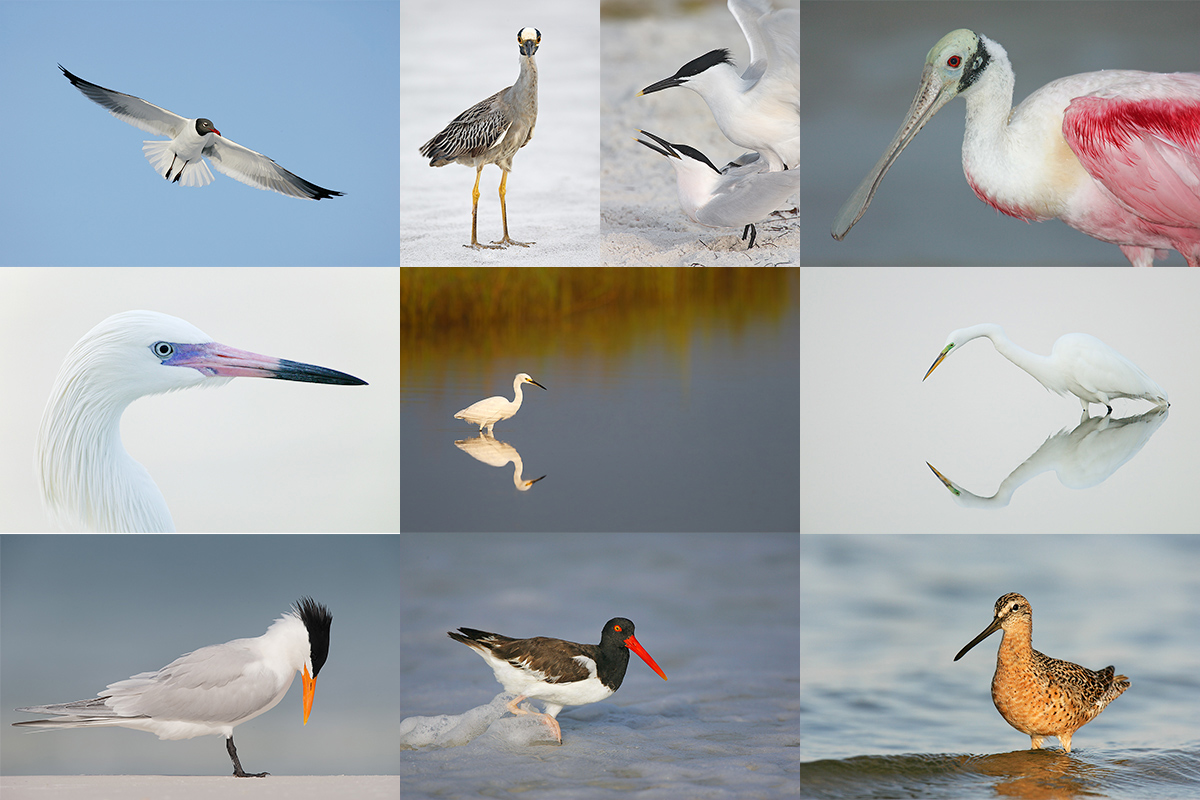What’s Up?
Patrick Sparkman kindly loaned me his 600 II, his two TCs, and his 5D Mark IV so that everything I would be working with had been micro-adjusted. I spent almost four hours on Monday morning standing in one spot. I created 1,115 images, all but about 20 of them of the same bird, a handsome male Anna’s Hummingbird. After the first edit I was able to get down to one House Sparrow image, 5 oriole images, and 137 hummer photos. Then Patrick helped me get down to the 24 best hummingbird photographs. One of those 24 graces today’s blog post.
I fly home from San Diego today on the wonderfully convenient Southwest Airlines SAN to MCO nonstop.
Gear Questions and Advice
Too many folks attending BAA IPTs and dozens of folks whom I see in the field, and on BPN, are–out of ignorance–using the wrong gear, especially when it comes to tripods and more especially, tripod heads… Please know that I am always glad to answer your gear questions via e-mail.
The Streak: 5!
Today’s blog post marks a totally insane, irrational, illogical, preposterous, absurd, completely ridiculous, unfathomable, silly, incomprehensible, what’s wrong with this guy?, makes-no-sense, 5 days in a row with a new educational blog post. As always–and folks have been doing a really great for a long time now–please remember to use our B&H links for your major gear purchases. For best results use one of our many product-specific links; after clicking on one of those you can continue shopping with all subsequent purchases invisibly tracked to BAA. Your doing so is always greatly appreciated. Please remember: web orders only. And please remember also that if you are shopping for items that we carry in the BAA Online Store (as noted in red at the close of this post below) we would of course appreciate your business.
Gatorland In-the Field Instructional Meet-Up
Join me in Kissimmee, FL as below, to photograph Great (with chicks in the nest) and Snowy Egrets in breeding plumage, Wood Stork, American Alligator (captive), and more. Tricolored Heron likely. We should get to make lots of head portraits of all the bird species and to photograph them building nests, displaying, copulating, and flying. Learn to see, find, and make the shot in cluttered settings. Learn exposure and how to handle WHITEs. Learn fill flash and flash as main light. All of the birds are free and wild.
This Weekend’s Schedule
Friday afternoon, 4pm till closing: $75
Saturday morning (early entry): 7:30 till 10am: $100. Lunch and Image Review: $75 additional.
Saturday afternoon till closing (late stay): $100.
Sunday morning (early entry): 7:30 till 10am: $100.
To pay for one or more sessions in full via credit card, call Jim or Jen in the office weekdays at 863-692-0906. You will be responsible for the cost of your Gatorland Photographer’s pass or passes. Please shoot me an e-mail if you have any questions.
|
|
|
This image was created at La Jolla with the hand held Canon EF 100-400mm f/4.5-5.6L IS II USM lens (at 400mm) and my very favorite camera body, the Canon EOS 5D Mark IV. ISO 800. Evaluative metering +1 stop: 1/80 sec. at f/5.6 in Manual mode was perfect. AWB. LensAlign/FocusTune micro-adjustment: -1. Four AF points up and two to the left of the center /AI Servo/Shutter Button AF was active at the moment of exposure. The selected AF point was right on the hummers head. Image #1: Anna’s Hummingbird on agave |
100-400 II
I travelled to The School for the Work with just my 100-400 II, a 1.4X III TC, and one of my 5D Mark IV bodies. I was supposed to fly home on 16 MAR but on the way to LAX I decided to stop by San Diego to visit the Sparkman’s and Dr. Cliff Oliver. So I was a bit under-gunned when Patrick found a beautiful male hummingbird that perched regularly in the same agave. When I made this image my TC was in the trunk of the car. That allowed me to go for a true habitat image, a small-in-the-frame bird in the agave.
Image Design Question
How would pointing the lens about 1/2 inch more to my right have improved this image?
|
|
|
This image was created at La Jolla, CA with the Induro GIT 304L/Mongoose M3.6-mounted Canon EF 600mm f/4L IS II USM lens, the Canon Extender EF 2X III, and my very favorite bird photography camera body, the Canon EOS 5D Mark IV. ISO 1600. Evaluative metering at zero: 1/160 sec. at f/9 in Manual mode was perfect. AWB. LensAlign/FocusTune micro-adjustment: 1. Two AF points to the right and two up from the center AF point/Manual selection/AI Servo/Shutter Button AF was active at the moment of exposure. The selected AF points was right on the bird’s eye. Image #2: Anna’s Hummingbird male with gorget lit up |
Borrowing Pat’s Gear
With Patrick returning to work on Monday I was able to borrow his 600 II and the rest of his stuff as noted above. It was a cloudy day so I went straight to the bird and stayed with him. For the first two hours he visited only sporadically but after that he sat and sat and sat for the better part of two hours. He would often sit on the same perch for five to ten minutes. For the image above I moved my tripod to get the edge of the underwater cave as background; this yielded a very nice gradient.
Your Favorite?
Don’t be lazy; leave a comment letting us know which image you like best and why? Which image more closely reflects your style–wide with lots of habitat or clean, tight, and graphic?
|
DeSoto in spring is rife with tame and attractive birds. From upper left clockwise to center: breeding plumage Dunlin, dark morph breeding plumage Reddish Egret displaying, breeding plumage Laughing Gull/front end vertical portrait, breeding plumage Laughing Gull with prey item, Laughing Gull on head of Brown Pelican, screaming Royal Tern in breeding plumage, Royal Terns/pre-copulatory stand, Laughing Gulls copulating, breeding plumage Laughing Gull/tight horizontal portrait, Sandwich Tern with fish, and a really rare one, White-rumped Sandpiper in breeding plumage, photographed at DeSoto in early May. |
Fort DeSoto Spring IPT/April 19-22, 2017. (meet & greet at 2pm on Wednesday April 19 followed by an afternoon session) through the full day on Saturday April 22. 3 1/2 DAYs: $1599. Limit 10/Openings 4. To save your spot, please call and put down a non-refundable deposit of $499.00.
I may be offering small group (Limit 3) Photoshop sessions on Sunday afternoon and Monday morning if necessary. Details on that TBA.
Fort DeSoto is one of the rare locations that might offer great bird photography 365 days a year. It shines in spring. There will Lots of tame birds including breeding plumage Laughing Gull and Royal and Sandwich Terns. With luck, we will get to photograph all of these species courting and copulating. There will be American Oystercatcher and Marbled Godwit plus sandpipers and plovers, some in full breeding plumage. Black-bellied Plover and Red Knot in stunning breeding plumage are possible. There will be lots of wading birds including Great and Snowy Egrets, both color morphs of Reddish Egret, Great Blue, Tricolored and Little Blue Heron, Yellow-crowned Night-Heron, and killer breeding plumage White Ibis. Roseate Spoonbill and Wood Stork are possible and likely. We should have lots of good flight photography with the gulls and terns and with Brown Pelican. Nesting Least Tern and nesting Wilson’s Plover are possible.
We will, weather permitting, enjoy 7 shooting sessions. As above, our first afternoon session will follow the meet and greet at 2pm on Wednesday April 19. For the next three days we will have two daily photo sessions. We will be on the beach early and usually be at lunch (included) by 11am. We will have three indoor sessions. At one we will review my images–folks learn a ton watching me choose my keepers and deletes–why keep this one and delete that one? The second will be a review of your images so that I can quickly learn where you need help. For those who bring their laptops to lunch I’d be glad to take a peek at an image or three. Day three will be a Photoshop session during which we will review my complete workflow and process an image or two in Photoshop after converting them in DPP. Afternoon sessions will generally run from 4:30pm till sunset. We photograph until sunset on the last day, Saturday, April 22. Please note that this is a get-your-feet and get-your-butt wet and sandy IPT. And that you can actually do the whole IPT with a 300 f/2.8L IS, a 400 f/4 ID DO lens with both TCs, or the equivalent Nikon gear. I will surely be using my 500 II as my big glass and have my 100-400 II on my shoulder.
|
DeSoto in spring is rife with tame and attractive birds. From upper left clockwise to center: Laughing Gull in flight, adult Yellow-crowned Night-Heron, copulating Sandwich Terns, Roseate Spoonbill, Great Egret with reflection, Short-billed Dowitcher in breeding plumage, American Oystercatcher, breeding plumage Royal Tern, white morph Reddish Egret, and Snowy Egret marsh habitat shot. |
What You Will Learn
You will learn to approach free and wild birds without disturbing them, to understand and predict bird behavior, to identify many species of shorebirds, to spot the good situations, to understand the effects of sky and wind conditions on bird photography, to choose the best perspective, to see and understand the light, to get the right exposure every time after making a single test exposure, and to design pleasing images by mastering your camera’s AF system. And you will learn how and why to work in Manual mode (even if you are scared of it).
The group will be staying at the Red Roof Inn, St. Petersburg: 4999 34th St. North, St Petersburg, FL 33714. The place is clean and quite inexpensive. Please e-mail for room block information. And please call Jim or Jennifer at 863-692-0906 to register. All will need to purchase an Annual Pass early on Tuesday afternoon so that we can enter the park at 6am and be in position for sunrise opportunities. The cost is $75, Seniors $55. Tight carpools will be needed and will reduce the per person Annual Pass costs. The cost of three lunches is included. Breakfasts are grab what you can on the go, and dinners are also on your own due to the fact that we will usually be getting back to the hotel at about 9pm. Non-photographer spouses, friends, or companions are welcome for $100/day, $350 for the whole IPT.
BIRDS AS ART Fort DeSoto In-the-Field Meet-up Workshop (ITFW): $99
Fort DeSoto Spring In-the-Field Cheap Meet-up Workshop (ITFW) on the morning of Sunday, April 23, 2017: $99
Join me on the morning of Sunday April 23, 2017 for 3-hours of photographic instruction at Fort DeSoto Park. Beginners are welcome. Lenses of 300mm or longer are recommended but even those with 70-200s should get to make some nice images. Teleconverters are always a plus.
You will learn the basics of digital exposure and image design, autofocus basics, and how to get close to free and wild birds. We should get to photograph a variety of wading birds, shorebirds, terns, and gulls. This inexpensive morning workshop is designed to give folks a taste of the level and the quality of instruction that is provided on BIRDS AS ART Instructional Photo-tours. I hope to meet you there.
To register please call Jim or Jennifer during weekday business hours with a credit card in hand to pay the nominal registration fee. Your registration fee is non-refundable. You will receive a short e-mail with instructions, gear advice, and meeting place one week before the event.


Please Remember to use my Affiliate Links and to Visit the New BAA Online Store 🙂
To show your appreciation for my continuing efforts here, we ask, as always, that you get in the habit of using my B&H affiliate links on the right side of the blog for all of your photo and electronics purchases. Please check the availability of all photographic accessories in the New BIRDS AS ART Online Store, especially the Mongoose M3.6 tripod head, Wimberley lens plates, Delkin flash cards and accessories, and LensCoat stuff.
As always, we sell only what I have used, have tested, and can depend on. We will not sell you junk. We know what you need to make creating great images easy and fun. And please remember that I am always glad to answer your gear questions via e-mail.
I would of course appreciate your using our B&H affiliate links for all of your major gear, video, and electronic purchases. For the photographic stuff mentioned in the paragraph above, and for everything else in the new store, we, meaning BAA, would of course greatly appreciate your business. Here is a huge thank you to the many who have been using our links on a regular basis and those who will be visiting the New BIRDS AS ART Online Store as well.
Be sure to like and follow BAA on Facebook by clicking on the logo link upper right. Tanks a stack.
Typos
In all blog posts and Bulletins, feel free to e-mail or to leave a comment regarding any typos or errors. Just be right :).


















I like ’em both but the 2nd one is just ahead for me.
Move to the right 1/2 inch would give the agave spike near the edge room to breath.
Even though the bird is small its tail still falls outside what must be a very narrow depth of field.
Love the colours, background and head angle.
D
Bingo on the spike and thanks for your kind words Kiwi.
a
I have always preferred habitat as a part of a bird picture. Head shots are beautiful but they have to be accompanied with an explanation of where I was to help put the picture in context. A bird in its habitat tells me much more. I know a lot about this hummingbird with no explanation at all. Both pics are beautiful.
Moving to the right would put the agave in the corner of the frame but would the bird have blended into the agave that is in the background? I love the first image with the muted background color and the bright color of the bird. I photograph this way to show the habitat and crop to get tight, if not too severe, if necessary.
Pointing the lens a bit to the right not me moving anywhere 🙂
a
This stunning bird is the subject, and accordingly, the photo should be tight. I do not often leave comments, but this shot angle and composition compelled me to do it.
My preference is for the second image, but the first looks great too.
Hi Artie, I like image II better…you have captured details so well… that enhances the bird’s beauty and very reason I got into bird photography — as what details camera revealed was (1) my eyes could not see, and (11) blew me away…
By the way, looking forward to your blog on exposure settings for birds in flight.
For me, definitely image 2. The most fascinating thing to me about bird photography using a super tele lens is the ability to reveal incredible detail that usually is not seen with the naked eye. This image is one that demonstrates that property in spades.
Me too 🙂
later and love, artie
Hi Artie. I like the close-up better, but I don’t think I’d move the lens to the right, even though it might put the agave into the corner. Question: How do you deal with the LensAlign micro adjustment with a borrowed lens?
Mike
I should have moved the lens a bit to the right. The question remains why.
I used Patrick’s gear including his camera 🙂 He is a champion at micro-adjusting.
a
Thanks for the reply. And I thought you meant the close-up re:
moving the camera. I should have caught that spike.
Do we really have to choose? They are so different. If I had to, I would also choose #2 because of the vibrancy and detail in the head that really gets your attention. Landing on the point of an agave leaf must take a lot of confidence and skill…
Just catching up with your posts. What happened to end your post streak? I see that it’s back down to five, after being over 450+…
It was 480. I went to The School for the Work for nine days and had a blast.
a
My favorite is #2.
As far as style…I’ve always loved mine big in the frame,
which a lot of photographers don’t like, which is okay by
me. But like I tell them, I’m not photographing for other
photographers, I’m clicking the shutter for what I like and
the John/Jane Doe’s that visit my table when I’m selling
prints or giving a presentation.
Plus, I feel sorry for those little birds…they deserve to be
presented big for once in their lives 🙂
Doug